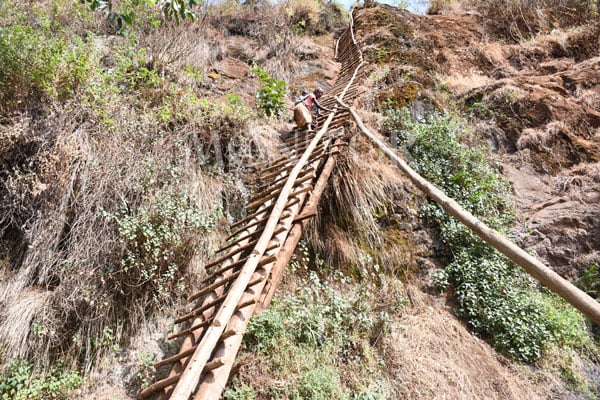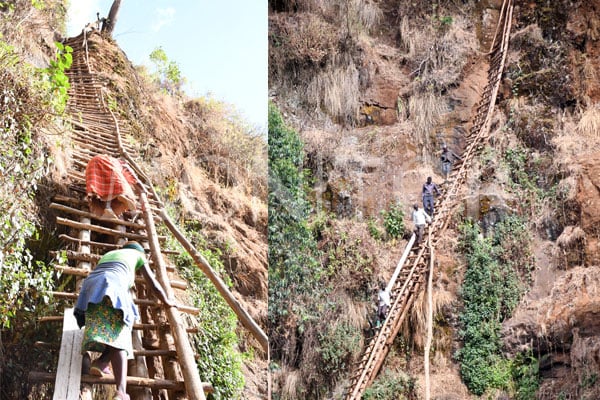Prime
Mt Elgon locals suffer broken limbs while descending ladder

A woman with a baby on her back climbs the wooden ladder in Manyololo Village, Bulambuli District. PHOTO/ MICHEAL WONIALA
What you need to know:
- The villagers also descend and climb the steep ladder every day to trade their produce in the nearest markets
The people living on the slopes of Mt Elgon in Bulegeni Sub-county, Bulambuli District, have for long faced challenges in accessing social services such as education and health care.
The villages on the mountain slopes can only be accessed using a long wooden ladder that connects to the low-lying areas, where most of the essential social services are found.
The ladder is used by pupils and students from the mountaintop to access education in schools in the low-lying areas.
The villagers also descend and climb the steep ladder every day to trade their produce in the nearest markets.
This publication has learnt that hundreds of people have suffered broken limbs while others died ascending or descending the perilous ladders.
Ms Mary Wanyenze, who uses the ladder on a daily basis to Masheluse Village, describes her experience as “scaring”.
“We are always surviving on the mercy of God. Tomorrow is not certain. It’s very risky but we don’t have anything to do. We don’t have any other alternative routes,” she says.
Ms Joseph Gidongo, a businessman, says they spend close to 30 minutes descending the ladder and the same time ascending.
“Children drop out of school at a very tender age because they can’t climb the ladder every day, it’s very risky, especially when it rains, so many end up sitting at home and eventually lose interest in education,” he says.
Frustrations
Mr David Makoba, 73, says for a long time, they have asked the leaders to construct for them a suspended or metallic bridge in vain.
“We keep shifting them across the ridge whenever they become old or the place develops cracks,” he says.
Mr Francis Woniala, the chairperson of Manyololo Village, says the area experiences a high school dropout because of lack of access to schools.
“We have a very high dropout rate of our children because it’s very risky for them to climb and descend the wooden ladder every day. It’s very scary for our children, actually, it traumatises them” he says.
Mr Woniala says because of the terrain, they also have high rates of teenage pregnancies and early marriages of girls between the ages of 14 and 15.
Another resident, Ms Annet Namataka says she once broke her left leg while climbing the ladders when it had rained last year. “I fell off in the middle and I only survived death by a whisker,” she says. Ms Namataka’s story is not any different from that of Ms Mary Namono, who attributes the high rates of women who deliver through traditional birth attendants to lack of access to health services.
“Women cannot access the health centre when they are pregnant, so the alternative is to use traditional birth attendants,” she says.
Rainy season blues
Dr Joseph Wamala, who works with Baylor Uganda that is involved in HIV/Aids treatment, says the mountainous terrain of the place makes it hard for sick people to access services.
“Sick people cannot be easily reached, so we have to get community health workers, who pack the drugs and take them to their homes but it’s very difficult whenever it rains,” Mr Wamala says.
Ms Annet Nandudu, the Bulambuli District chairperson, said the Uganda National Roads Authority should come in and find a more suitable way for people to move from the top of the mountain to access services to the low-lying areas.






